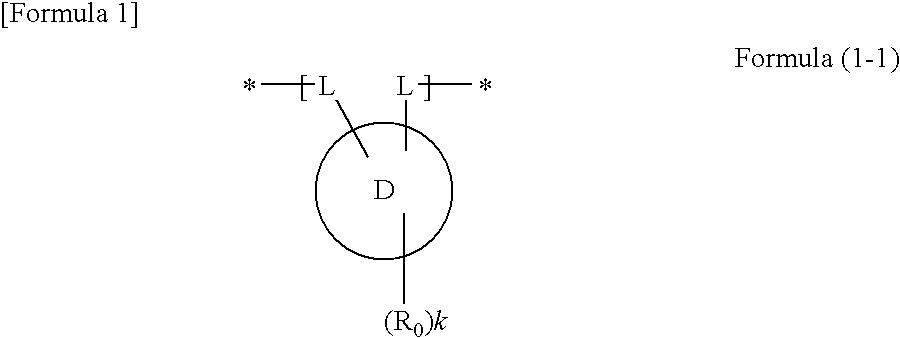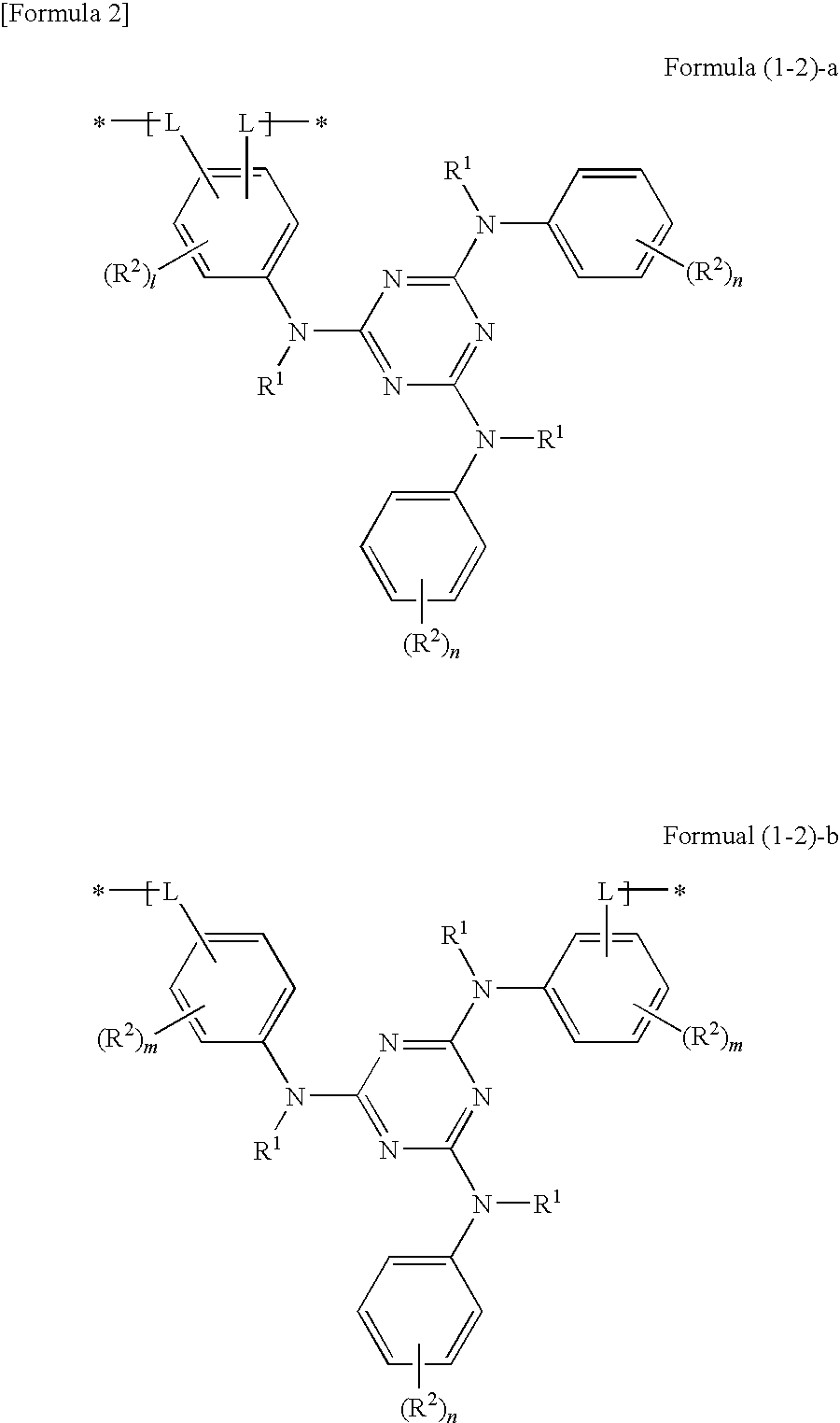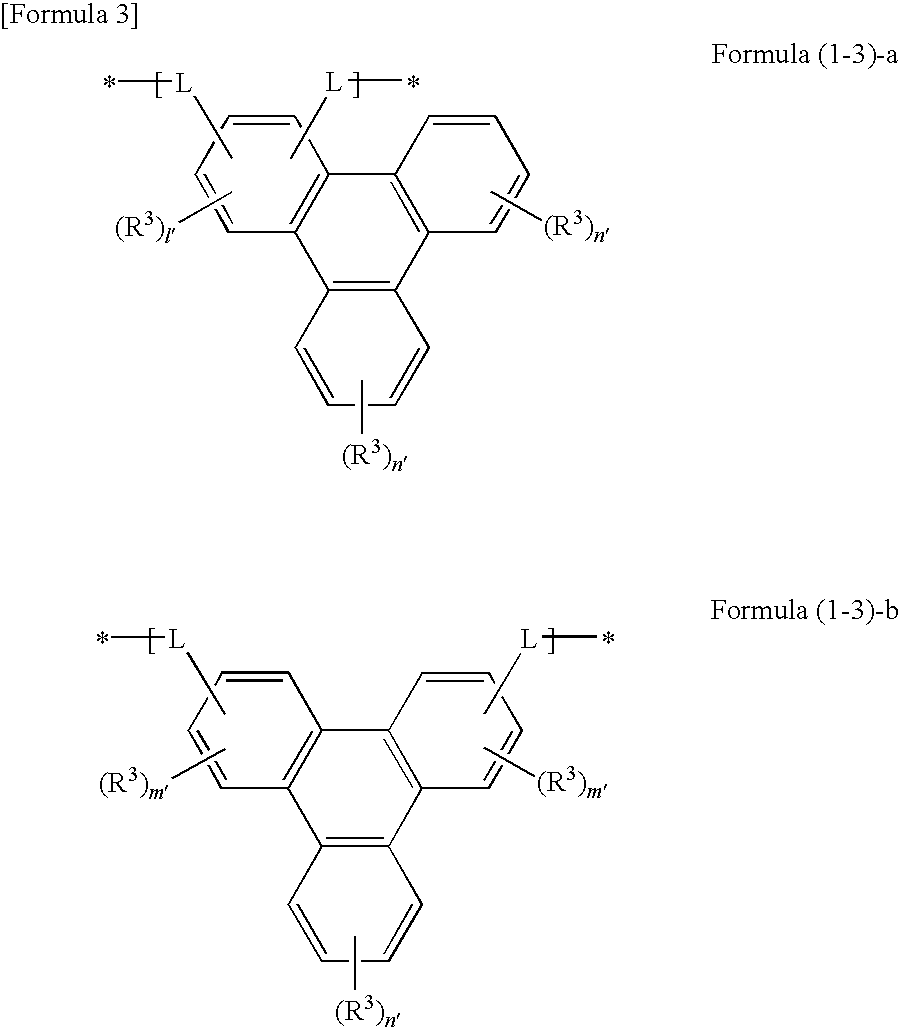Lubricant Composition
a technology of lubricating oil and composition, which is applied in the field of lubricating oil composition, can solve the problems of poor viscosity increasing effect, poor viscosity index increase, and lubricating oil in this case may drastically degrade in shearing stability, so as to improve the durability of lubricating oil, improve the viscosity index, and increase the viscosity
- Summary
- Abstract
- Description
- Claims
- Application Information
AI Technical Summary
Benefits of technology
Problems solved by technology
Method used
Image
Examples
example 1-1
Preparation of Polymer Having Mesogen Structure (Including Discotic Structure) in the Main Chain
[0102]General methods of synthesizing triphenylene rings (Exemplary Compounds DMP-1 to 13) as the mesogen structure are detailed in Liquid Crystals., Vol. 31, No. 8, p. 1037 (2004) and the cited references thereof, wherein the methods of synthesis may vary depending on bonding modes between the main chains of the polymer.
[0103]For example, as for Exemplary Compounds DMP-1 to 8, and DMP-52 to 58, the mesogen rings were combined in the same manner as the synthetic method described in Makromol. Chem. Rapid Commun., Vol. 6, p. 577 (1985).
[0104]As for Exemplary Compounds DMP-9 to 18, DMP-21 to 25, DMP-35 to 44, and DMP-49 to 51, the mesogen rings were combined in the same manner as the method described in Macromolecules, Vol. 23, p. 4061 (1990).
[0105]As for Exemplary Compounds DMN-26, 27, 30, and DMP-45 to 48, the mesogen rings were combined in the same manner as the method described in J. Che...
examples 1-2 to 16
, Comparative Examples 1-1 to 3, Referential Examples 1-1 and 1-2
Preparation of Lubricating Oil and Evaluation of Effect of Improving Viscosity Index of Highly-Soluble Discotic Polymer
[0110]Five parts by mass of the polymers having the mesogen structures obtained in Example 1-1 and 95 parts by mass of Super Oil N-32 (from Nippon Steel Chemical Co., Ltd.) as the base oil for lubricating oil were heated to 100° C. under microscopes (microscopic heating device FP-80HT Hot Stage from Mettler Inc., and OPTIPHOT-POL from Nikon Corporation) at a 400× magnification, and 15 parts by mass of those confirmed that an extremely small amount of micro-solid matters seen at 40° C. were completely dissolved when heated to 100° C. (DMP-3, 10, 15, 21, 30, 31, 35, 44, 51, 52, 55, 56, 59, 60, 61) were mixed with 85 parts by mass of N-32, to thereby prepare lubricant compositions.
[0111]As Comparative Examples, lubricant compositions were prepared according to a similar method, respectively using a polyme...
examples 1-17 and 18
, Comparative Examples 1-6 and 7
Evaluation of Various Performances Relating to Function of Improving Viscosity Indices of Highly-Soluble Samples
[0117]Fifteen parts by mass of discotic polymers DMP-15, DMP-35, and CP-1, CP-2 for comparison, and 85 parts by mass of N-32 were respectively mixed to thereby prepare the lubricant compositions.
[0118]Various performances relating to performance of improving viscosity indices were evaluated similarly to as in Example in the above. Results are shown in Table 1-2 and Table 1-3.
(Viscosity Properties at Low Temperatures)
[0119]MRV (mini-rotary viscometer), CCS (cold-cranking simulator) and TP-1 of thus prepared lubricant compositions were respectively measured. Results are shown in Table 1-2. The MRV, CCS and TP-1 are values expressing viscosity properties of composition at low temperatures.
[0120]MRV (mini-rotary viscometer) is measured according to a method described in ASTM-D3829, wherein viscosity is measured on the centipoise basis. Measureme...
PUM
| Property | Measurement | Unit |
|---|---|---|
| mean particle size | aaaaa | aaaaa |
| temperatures | aaaaa | aaaaa |
| bond-length | aaaaa | aaaaa |
Abstract
Description
Claims
Application Information
 Login to View More
Login to View More - R&D
- Intellectual Property
- Life Sciences
- Materials
- Tech Scout
- Unparalleled Data Quality
- Higher Quality Content
- 60% Fewer Hallucinations
Browse by: Latest US Patents, China's latest patents, Technical Efficacy Thesaurus, Application Domain, Technology Topic, Popular Technical Reports.
© 2025 PatSnap. All rights reserved.Legal|Privacy policy|Modern Slavery Act Transparency Statement|Sitemap|About US| Contact US: help@patsnap.com



